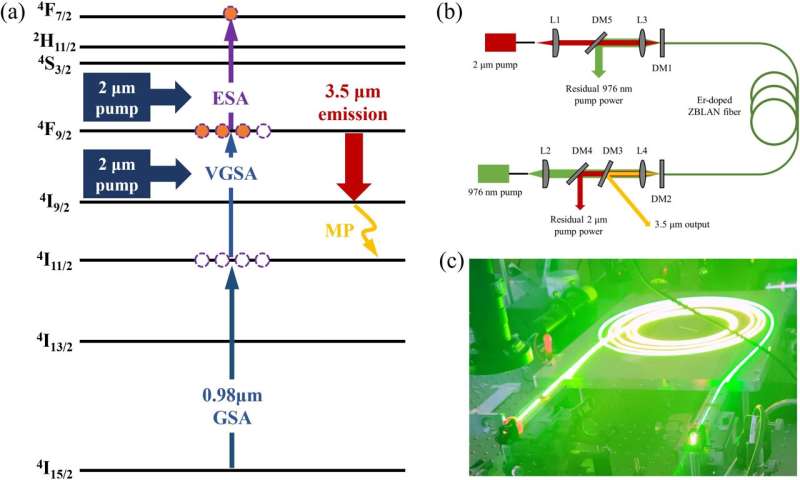Minor wavelength optimization causes large power improvement in ZBLAN fiber laser

Recent attention has been devoted to develop high-power mid-infrared fiber lasers due to their applications in free-space communication, atmospheric remote sensing, and high-resolution spectroscopy. With the "0.98 μm+2 μm" dual-wavelength pumping scheme, mid-infrared laser emission at 3.5 μm can be obtained from Er-doped fluoride fiber laser.
However, an intrinsic excited state absorption (ESA) also exhibits absorption at 2 μm pump wavelength, which reduces the pump quantum efficiency. Even worse, the ESA starts from the upper lasing level and depletes the population inversion, resulting in strong quenching (output drop at higher pump power). This behavior is the main obstacle that hinders the power scaling of 3.5 μm Er-doped fluoride fiber laser.
Researchers led by Prof. Shi Wei at Tianjin University, China, have proposed a novel method for optimizing the pump wavelength to balance the pump absorption and ESA for alleviating the laser quenching. The work entitled "Pump quantum efficiency optimization of 3.5 μm Er-doped ZBLAN fiber laser for high-power operation" was published in Frontiers of Optoelectronics.
Considering that the ESA process exhibits an absorption peak at ~ 1913 nm, longer pump wavelength results in decreased ESA cross section, which can reduce ESA-induced pump absorption and thus help to increase the pump quantum efficiency.
This scheme allows for lower 976 nm pump power and shorter gain fiber for achieving quenching-free operation, and it thus more cost-effective while also reducing the heat generation.
With an optimized pumping wavelength at 1,990 nm, 7.2 W laser output at 3,460 nm and a slope efficiency of 36% were obtained, both of which are much higher than the results achieved with a conventional pumping scheme. Further power scaling can be anticipated with a low-loss all-fiber configuration.
More information:
Lu Zhang et al, Pump quantum efficiency optimization of 3.5 μm Er-doped ZBLAN fiber laser for high-power operation, Frontiers of Optoelectronics (2023). DOI: 10.1007/s12200-023-00089-w
Provided by Higher Education Press